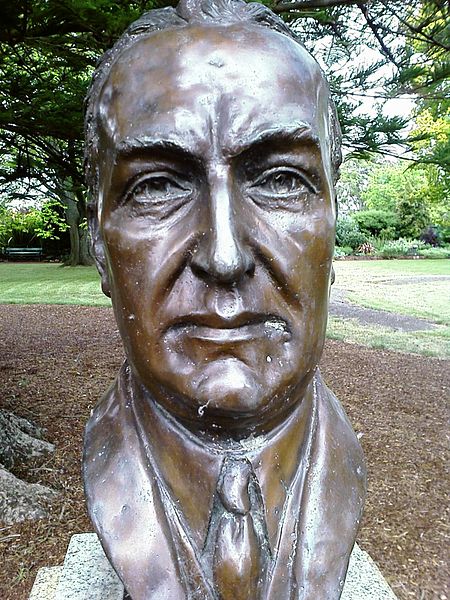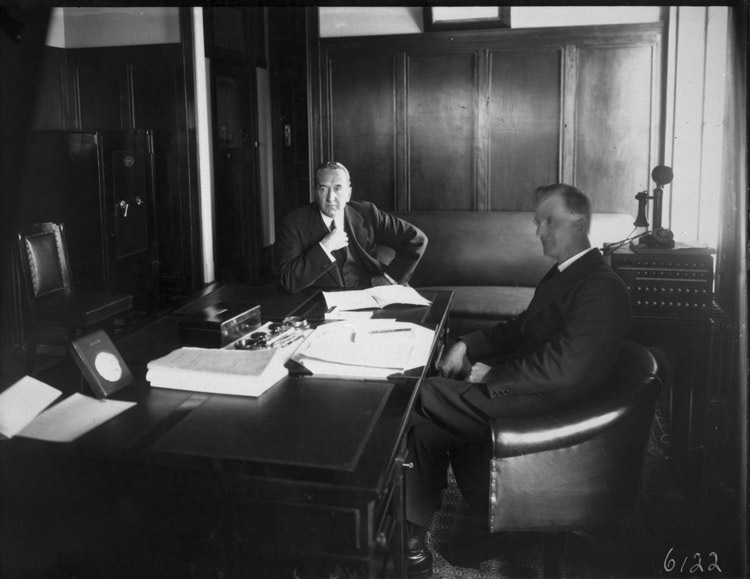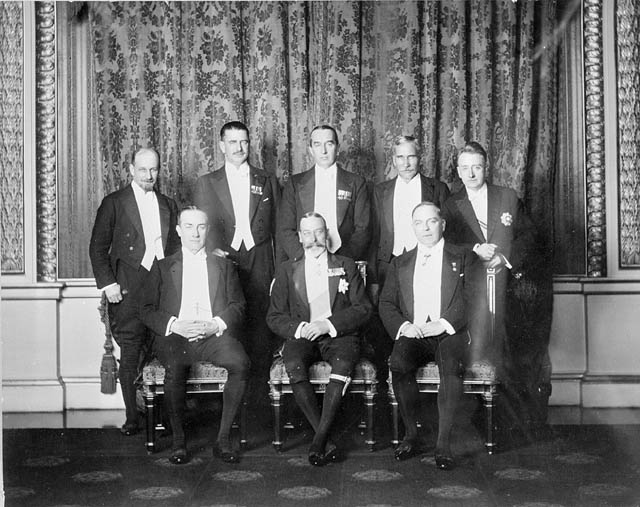<Back to Index>
- Physicist Johannes Stark, 1874
- Poet Nikolay Stepanovich Gumilev, 1886
- 8th Prime Minister of Australia Stanley Melbourne Bruce, 1883
PAGE SPONSOR
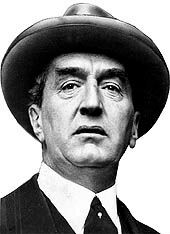
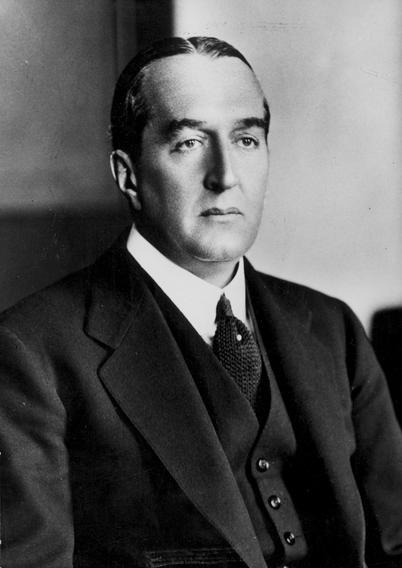
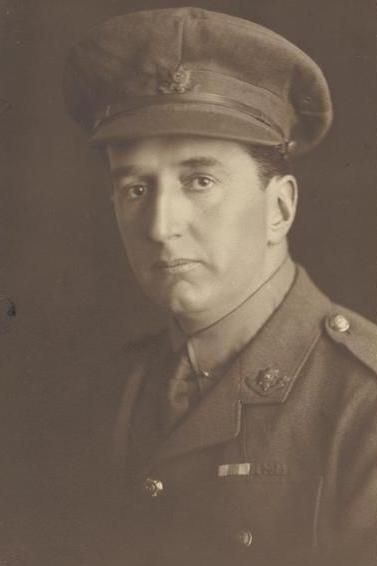
Stanley Melbourne Bruce, 1st Viscount Bruce of Melbourne, CH, MC, FRS, PC (15 April 1883 – 25 August 1967), was an Australian politician and diplomat, and the eighth Prime Minister of Australia. He was the second Australian granted an hereditary peerage of the United Kingdom, but the first whose peerage was formally created. He was the first incumbent Prime Minister to lose his seat at an election; the only other being John Howard in 2007.
Stanley Bruce was born in a mansion on Grey Street, St Kilda, a Melbourne suburb, in 1883; however, his family moved shortly after to a new mansion, "Wombalano", built in Kooyong Road, Toorak (now owned by the Murdoch family). The boy's father, of Scottish descent, was a prominent businessman.
Bruce was educated at Glamorgan (now part of Geelong Grammar School), Melbourne Grammar School,
and then at Cambridge University. After graduation he studied law in
London and was called to the bar in 1907. He practised law in London,
and also managed the London office of his father's importing business. When World War I broke out he joined the British Army, and was commissioned to the Worcestershire Regiment, seconded to the Royal Fusiliers. In 1917 he was severely wounded in France, winning the Military Cross and the Croix de guerre. Bruce
was invalided home to Melbourne, and soon became involved in recruiting
campaigns for the Army. His public speaking attracted the attention of
the Nationalist Party, and in 1918 he was elected to the House of Representatives as MP for Flinders, near Melbourne. His background in business led to his being appointed Treasurer (finance minister) in 1921. The Nationalist Party lost its majority at the 1922 election, and could only stay in office with the support of the Country Party. However, the Country Party let it be known it would not serve under incumbent Prime Minister Billy Hughes.
This gave the more conservative members of the Nationalist Party an
excuse to force Hughes to resign; the conservatives had only tolerated
Hughes in order to keep the Australian Labor Party out of power. Bruce was chosen as Hughes's successor. Bruce then entered negotiations with the Country Party, leader, Sir Earle Page,
for a coalition government. On 9 February 1923 he became prime
minister at the age of only 39, at the head (despite being the youngest
member) of a Nationalist - Country coalition government.
He had to pay a high price in the process, though; he was forced to
give the Country Party five posts in a Cabinet of only eleven members,
including the Treasury portfolio,
and the position of Deputy Prime Minister (which went to Page). These
demands were unheard of for such a young party in the Westminster system. Nonetheless, Bruce readily agreed, if only to avoid forcing another election. Bruce's
appointment marked an important turning point in Australian political
history. He was the first Prime Minister who had not been involved in
the movement for federation, who had not been a member of a colonial
Parliament, and who had not been a member of the original 1901 federal
Parliament. He was, in addition, the first Prime Minister to head a
cabinet consisting entirely of Australian born ministers. With his aristocratic manners and dress – he drove a Rolls Royce and wore white spats – he was also the first genuinely "Tory" Australian Prime Minister. In
general Bruce formed an effective partnership with Page, and exploited
public fears of Communism and militant trade unions to dominate
Australian politics through the 1920s. Despite predictions that
Australians would not accept such an aloof leader as Bruce, he won a
smashing victory over a demoralised ALP, led by Matthew Charlton, at the 1925 election. Throughout his term of office, he pursued a policy of support for the British Empire, the League of Nations, and the White Australia Policy: "We
intend to keep this country white and not allow its peoples to be faced
with the problems that at present are practically insoluble in many
parts of the world." In his policy launch speech made at the Shire Hall in Dandenong, south - eastern Melbourne, on 25 October 1925, Bruce reiterated his government's commitment to the White Australia Policy: "It
is necessary that we should determine what are the ideals towards which
every Australian would desire to strive. I think those ideals might
well be stated as being to secure our national safety, and to ensure
the maintenance of our White Australia Policy to continue as an
integral portion of the British Empire." On 8 July 1928 he was appointed a Companion of Honour. His government was reelected, though with a significantly reduced majority, in1928. Strikes
of sugar mill workers in 1927, waterside workers in 1928, then of
transport workers, timber industry workers and coal miners erupted in
riots and lockouts in New South Wales in 1929. Bruce responded with a
Maritime Industries Bill that was designed to do away with the Commonwealth Court of Conciliation and Arbitration and return arbitration powers to the States. On
10 September 1929, Hughes and five other Nationalist members joined
Labor in voting against the Bill. The Bill was lost by 34 votes to 35
when Littleton Groom, the Speaker, abstained, bringing down the Bruce – Page government and forcing the 1929 election. Labor, now led by James Scullin (Charlton
had resigned from the party's leadership in 1928), won a landslide
victory, scoring an 18 seat swing (at the time, this was the
second biggest swing in Australian history). Bruce was defeated by
Labor's candidate Jack Holloway in
his electorate of Flinders. An independent Liberal candidate's
preferences flowed mostly to Holloway, thus making Bruce the first
sitting prime minister to lose his seat. The only other sitting
Australian prime minister to be defeated in his own electorate is John Howard, at the 2007 election. After his 1929 electoral defeat, Bruce went to England for personal business reasons and contested the 1931 election from that country as a member of the United Australia Party (a
merger of Bruce's Nationalists and Labor dissidents). He won his seat
back, becoming the first person (and, to date, the only person) ever to
be re-elected to parliament after serving as Prime Minister and leaving
the House of Representatives. He was named a Minister without portfolio in the government of Joseph Lyons.
Lyons quickly dispatched Bruce back to England to represent the
government there and he led the Australian delegation to the 1932 Ottawa Imperial Conference. In 1933 Bruce resigned from Parliament in order to take the position in London as Australian High Commissioner to the United Kingdom. He held this post with great distinction for 12 years, playing a notable role in the Abdication Crisis triggered by Edward VIII, and representing Australia's interests in London during World War II. He was appointed a member of the Imperial War Cabinet and the Pacific War Cabinet. In 1947 he became the first Australian created an hereditary peer when he was made Viscount Bruce of Melbourne, of Westminster Gardens in the City of Westminster (Sir John Forrest was
to have been similarly honoured in 1918, and his peerage was even
publicly announced, but he died before it was officially created.) He was the first Australian to take his seat in the House of Lords. Bruce
divided the rest of his life between London and Melbourne. He remained
Australian High Commissioner until 1945; subsequently he represented
Australia on various UN bodies, and his name was considered for the
position of United Nations Secretary - General. He was the chairman of the World Food Council for five years. Bruce was appointed as the first Chancellor of the Australian National University and served from 1951 until 1961. The residential college, Bruce Hall at the Australian National University in Canberra was named in honour of Lord Bruce.
Bruce married Ethel Dunlop Anderson (born 25 May 1879) in 1913. They
had no children. He died in London on 25 August 1967, aged 84. As he
was childless the viscountcy became extinct. He was cremated and his
ashes were scattered on Canberra's Lake Burley Griffin. Viscountess Bruce of Melbourne died on 16 March 1967, only a few months before her husband.
In 1972 Bruce was honoured on a
postage stamp bearing his portrait issued by Australia Post. The Canberra suburb of Bruce, and the electoral Division of Bruce based in south - east Melbourne, are both named after Stanley Bruce. Melbourne
Grammar School also has a house named after him, Bruce House. Bruce
Hall, at the Australian National University, is also named in his
honour.
